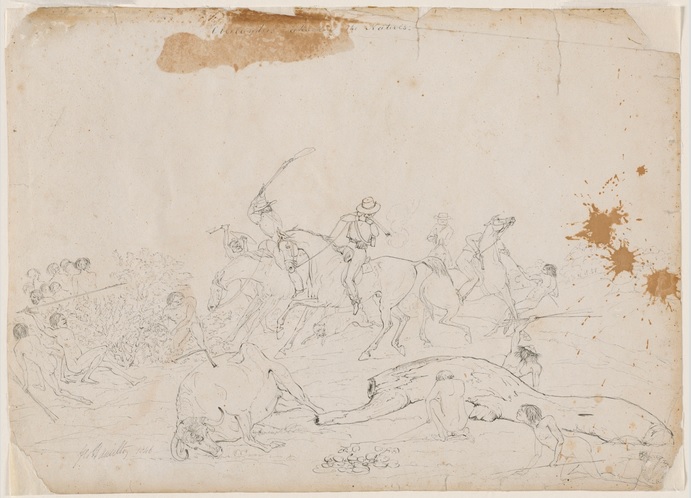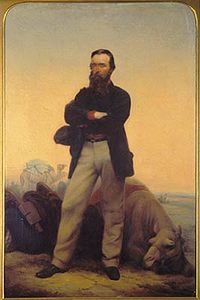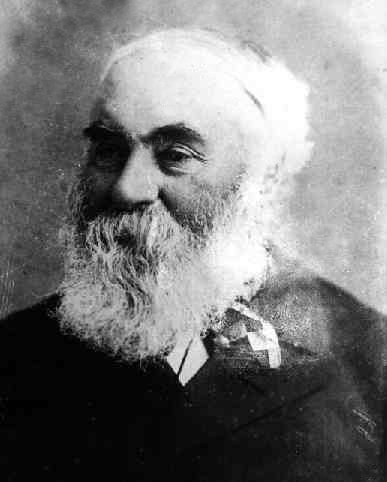George Hamilton was in charge of Henry Howey’s overlanding expedition that crossed the Murray River in the vicinity of the crossing place in mid-1837. They crossed 3,000 sheep losing twelve to drowning plus floated across two wagons, one of which carried the men who could not swim. Hamilton wrote that his convict servants feared an attack by Aboriginal people however, these fears were proved unwarranted. On the night they crossed the Murray River they were joined by an Aboriginal man who presented Hamilton with a freshly caught cod fish saying there were some dead sheep on the opposite bank and requested that he and his people might have them. Hamilton agreed and the man departed in his canoe to the opposite bank where was soon heard ‘woops’ of delight and shortly afterwards there appeared many lights in the form of flaming torches made of resinous pine branches. (1)
It is interesting to note that the Aboriginal man who presented Hamilton with the cod fish spoke passable English and wore a King Plate engraved with ‘King Tommy’ which had been presented to him by Governor Bourke. (1) Governor Bourke was in Melbourne on 8th March 1837 and presented four Aboriginal men with King Plates. It is possible King Tommy received his plate at that time. Some more research will need to be done to identify the four recipients – apparently, William Buckley made a list of the names and gave these to Capt Lonsdale. (2)
George Hamilton, overlander, artist and police commissioner, was born on 12 March 1812, probably in Hertfordshire, England, one of at least eight children of Charles Hamilton. Following education at Harrow School in 1823-26, George served in the navy as a midshipman. He reached Sydney sometime before 1837. (3)
During the month of February in 1837, George Hamilton was leading Howey’s overland expedition of between 3,000 and 4,000 sheep somewhere near Goulburn when he had his first adventure. (1) An article in the Australian dated 31st March reported the ‘melancholy loss of life and property’ lamenting Hamilton had been murdered by the Aborigines. The reason for this belief was a report that ‘a few cattle, known to be those of the party, have been found….and some of the dray bullocks have returned to their old run with the yokes about their necks. There seems no reason to believe but that the party have been surprised and murdered.’ (4)
Hamilton was in fact lost somewhere near Goulburn. he had gone in search of 240 sheep who had taken fright in the night when possums ran among them. When Hamilton reunited with his party and learned of the search for his body he wrote a letter dated March 30th 1837, which he handed to Mr Robert Allen of Goulburn. The letter was published on Saturday 8th April. (5)
The Australian newspaper printed an article criticising the deep-rooted spirit of revenge and the indiscriminate slaughter of Aboriginal people. (6)
The Sydney Monitor, Friday 7th April, published an article attempting to stir up outrage over the loss of Hamilton and his party. It reported, ‘there is every reason to fear the worst.’ The article attempted to stir up outrage towards Aboriginal people suggesting pre-emptive strikes such as the slaughter of Blacks by Major Mitchell at mount Dispersion was a correct and prudent act. (7)
For the next few years he combined mixed farming along with his artistic talents, both visual arts and authorship, all of which had considerable merit, but none of which were a resounding success.In 1848 he accepted a position as clerk with the Colonial Treasury and when the Gold Escorts from the Victorian Goldfields were established, he transferred in May 1852 to become Bullion Clerk in the busy Gold Escort Office. (14)
On 1 December 1853, he joined the South Australian Mounted Police with the rank of Inspector. He progressed gradually through the ranks. Around 1860 he was appointed Chief Inspector and also acted in the position of Commissioner on occasion. During this period he was an activist for the humane treatment of horses, publishing two significant books on that topic, these early endeavours in the prevention of animal cruelty are now recognised at the National Museum of Australia. (14)
The drawing below is from George Hamilton’s, ‘Treatment Of The Horse In Australia’ published in the 1860s, which used graphic images to illustrate the cruelty used in the breaking in of a horse to saddle.

This picture is very disturbing in the present day when natural horsemanship has proved that the pressure and release method is quicker and far kinder to all concerned. The brutality Hamilton depicts gives an indication of the cruelty and cheapness of life that was metered out to animals and humans alike. Hamilton’s description of the scene above is thus: “He is branded and has his tail cut off. After the tail has been cut off, the brand of hot iron is applied to the skin…. By this time the animal … has had so many ‘surprises’ that he has exhausted his stock of astonishment and ‘shut up shop,’ and he now lies quietly submitting to whatever man may please to do with him. After he is branded, his legs are loosened, and he is directed to ‘get up’; this direction is generally accompanied with a kick on the stomach, and flavoured with an oath or two, roared out at the top of the civilized man’s voice to the savage untutored dumb animal on the ground. The horse having risen and shaken himself, looks round in an amazed and muddle brained way at his tormentors…” (15)
For all of George Hamilton’s artistic talents and poetical descriptions of the Australian bush, he left us with some disturbing drawings such as ‘Overlanders attacking the natives’ dated1846 and held in the State Library of N.S.W. digital collections.


George Hamilton, Police Officer South Australia
ILLUSTRATIONS:
Overlanders Attacking The Natives, George Hamilton 1846, Original held at State Library of NSW digital collections.
‘Treatment Of The Horse In Australia’ illustrations and text by George Hamilton, published in the 1860s,

Old colonists, 1838-1840
REFERENCES:
(1) George Hamilton, Experiences of a Colonist, 1846 page 80.
(2) Governor Bouke gave out 4 King Plates on March 8th 1837 in Melbourne – Historical Records of Victoria, Foundation Series, Vol 1. Beginnings of Permanent Government. pg 102.
(3) Australian Dictionary of Biography – George Hamilton
(4) Newspaper article reporting George Hamilton attacked by hostile Aborigines
(6) Article sympathising with Indigenous people
(7) Article inciting the killing of Indigenous people
(8) Charles Bonney wrote of meeting up with George Hamilton during the last leg of the overlapping journey to the Macedon Ranges. For more information on Charles Bonney see his profile on this site.
(9) Alexander Fullerton Mollison, An Overlanding Diary.
(10) John Pascoe Fawkner’s Melbourne newspaper, 4th edition.
(11) https://adb.anu.edu.au/biography/minchin-william-2460
(12) Gisborne Gazette
( 13) https://en.wikipedia.org/wiki/White_woman_of_Gippsland
(14) https://en.wikipedia.org/wiki/George_Hamilton_(Australian_police_officer)
(15) Treatment Of The Horse In Australia by George Hamilton


